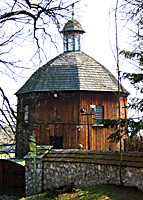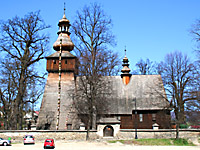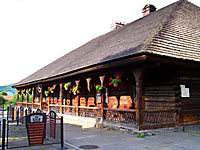Wooden Architectural Beauties of the Krakow Region
Hundreds of graceful centuries-old wooden churches, as well as other
ancient timber buildings from manor houses to inns to peasant
cottages to industrial facilities such as mills, have survived in
the Malopolska (Lesser Poland) province
whose capital city is Krakow.
Since 2003 four of them – in the villages of Sekowa, Binarowa,
Lipnica Murowana and Debno Podhalanskie – have featured on the
UNESCO List of the World Cultural and Natural Heritage. At the
same time, scores of wooden churches in the Malopolska region can
match the chosen foursome.
Monuments of wooden architecture in the city of Krakow
Also Krakow itself can boast many vintage buildings of wood within
the city limits such as the octagonal St. Margaret’s chapel (Kaplica
Sw. Malgorzaty) of 1690 at Blogoslawionej Bronislawy street in the
Salwator neighborhood. Also, there is a somewhat forsaken folk
architecture park at the end of Kasztanowa street in the Wola
Justowska residential area, on the edge of the Las Wolski forest,
with wooden buildings transferred from various Malopolska villages.
Unfortunately, its 17th-century church has been burned so you may
see only the 18th-century inn and a timber granary of 1764.

St. Margaret’s chapel (Kaplica Sw.
Malgorzaty) of 1690 in the Krakow's Salwator district.
A large wooden church near the Cistercian Abbey (Opactwo Cystersow)
in the Mogila area of
Nowa Huta district dates back to 1466 being one of
Poland's oldest timber buildings. The St. Bartholomew's church (Kosciol
Sw. Barlomieja) at 226 Klasztorna street underwent major renovations
in 1587 and in the second half of the 18th century. Its gate/belfry
with shingled domed roof dates from 1752. A wooden pointed gothic
portal with inscription and date "1466" has survived inside the
church. Other notable feature of the interior are rococo frescos of
1766.

The old church of larch wood in Rabka, a
resort town 60 km south of Krakow, dates back to 1606
and has been turned to a museum in 1936.
Malopolska wooden architecture on the World Heritage List of UNESCO
St. Leonard's Church (Kosciol Sw. Leonarda) in the village of
Lipnica Murowana some 50 km southeast of Krakow. This modest
single-nave church with a shingled, ridged roof dates back to the
end of the 15th century. Its interior boasts mostly baroque decor
yet the ceiling paintings date from the 15th, the 16th, and the 17th
centuries. In the 17th century also wooden arcades have been
attached on the outside. Tradition has it that the church was built
on the site of a pagan shrine around the idol of the four-faced
god Swiatowit that now props up the back of the altar of St
Leonard.
Church of St. Archangel Michael (Kosciol Sw. Michala
Archaniola) in the village of Debno Podhalanskie roughly 90 km south
of Krakow. The late-15th-century church built of larch and fir has
shingled roofs. The ceiling of its nave and chancel are of exposed
timber planks. Well-preserved, beautiful paintings of the early 16th
century cover entirely the walls inside. Noteworthy is the scene of
The Crucifixion in the rood screen with the crucifix from the end of
the 14th century. The altarpiece dates from the turn of the 15th and
16th centuries.
Church of St. Archangel Michael (Kosciol Sw. Michala
Archaniola) in the village of Bimarowa about 115 km southeast of
Krakow. Built circa 1500, the church has its walls covered with
shingles. The tower has been added in 1596 while the outside arcades
(so called sobotas) as well as a belfry and the chapel at the
northern side date from the 17th century. The church boasts rich and
valuable furnishings of the16th and the 17th centuries.
Church of SS Philip and Jacob (Kosciol Sw. Sw. Filipa i
Jakuba) in the village of Sekowa some 155 km southeast of Krakow.
The main body of the church has been built in 1520 of larch logs. A
short tower, a belfry, and wide exterior arcades have been attached
to it in the 18th century. Both the church roof and walls are
covered with shingles. Devastated in the Great War the church has
undergone masterful renovation by the end of past century. Inside,
an ornately sculptured and painted altarpiece embodies the
late-Renaissance art of the late 16th century. Also noteworthy is
the late-Gothic baptismal font of stone that dates back to 1522.

The 18th-century inn in Sucha Beskidzka, a town some
60 km southwest of Krakow, is one of stops on 'The Trail
of Wooden Architecture' that runs through the Malopolska
province.
The Wooden Architecture Route through the Malopolska region
Mindful of the value of the wooden architecture in the
Malopolska province
its government has stitched together various itineraries linking
ancient timber buildings. As a result, The Wooden Architecture
Route meanders through the region for over 1,500 km, connecting
248 sites – single buildings as well as complexes – including the
four churches listed as the World Heritage by UNESCO (see above).
They are marked and 600-plus special road signs direct drivers to
them.
Other UNESCO World Heritage sites in Krakow and the Malopolska Province
Krakow's Old Town historic district
Wieliczka salt mine
Auschwitz concentration camp
The Calvary sanctuary of Kalwaria Zebrzydowska
|
In the proximity
of Krakow
Krakow is Poland's tourist mecca, and also a gateway to
many other must-see sites in the region.
Malopolska
Province
Poland map
Free photos from the Malopolska region
Krakow
Poland's prime tourist attraction and a must in Central
Europe boasts numerous world-class monuments, charming vistas,
delightful atmosphere, and the best restaurants.
UNESCO World Heritage Sites in Krakow and nearby
In the footsteps
of Pope John Paul II
|





